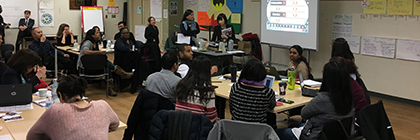
Talk about legacy. In spring of last year, York Professor Emeritus Nancy Nicol, documentary filmmaker and activist in the School of the Arts, Media, Performance & Design (AMPD), donated her collection to the Canadian Lesbian and Gay Archives (CLGA). The archives then established the Nancy Nicol Collection.
Based in downtown Toronto, the CLGA maintains the world’s largest independent LGBTQ+ archives. Its acquisition of Nicol’s collection is part of a long-term strategy to become a more active resource for the Canadian and LGBTQ+ communities.
Nicol, a York University alumna, describes her body of work, which documents a period of intense change in lesbian and gay rights in Canada between 1969-2009, as “a moving history, charged with optimism and resilience in the face of prejudice and ignorance.” She hopes her contribution to the Archives will be a way of remembering and celebrating this history, will provide vital materials for queer history students and researchers and will inspire future generations.
Nicol’s work reflects 40 years of lesbian and gay movement in Canada
Nicol, active in visual arts, video art, participatory documentary, research and writing since the late 1970s, taught in the Visual Arts Department at York from 1989 to 2016. Here, she assisted in the founding of the University’s Sexuality Studies and the Community Art Certificate programs.
Her contribution to filmmaking and social activism is vast, and it digs deeply into issues of human rights, social justice and struggles for social change. In her compelling documentaries, she interviewed many human rights lawyers, activists and community leaders. As a result, her work brings to life four decades of the history of the lesbian and gay movement in Canada.

Began in 1980s with a series on pro-choice movement
Nicol’s first ground-breaking documentary series was The Struggle for Choice (1986), which depicted the history of the pro-choice movement in Canada. She followed this up with films on women and work, labour struggles, reproductive rights, migrant workers’ rights in Canada and human rights in Northern Ireland.
In the 1990s, Nicol began what became a long-term project that traced decades of lesbian and gay rights organizing in Canada from decriminalization (in 1969) through the battles for human rights, relationship recognition and equal marriage up to 2009.
Her influential work extends beyond the border of Canada. In 2011, Nicol led an international research and participatory documentary project, “Envisioning Global LGBT Human Rights,” collaborating with 31 community partners based in Canada, Africa, the Caribbean and India.
The Envisioning project resulted in many outcomes, including publications and participatory documentaries. These works include No Easy Walk To Freedom (2014), which documents the struggle for decriminalization in India, as well as And Still We Rise (2015, co-directed with Richard Lusimbo) on resistance to the anti-homosexuality act in Uganda.
A forthcoming anthology, Envisioning Global LGBT Human Rights: (Neo)colonialism, Neoliberalism, Resistance and Hope, will be launched in June, 2018. It is edited by N. Nicol, A. Jjuuko, R. Lusimbo, N. J. Mulé, S. Ursel, A. Wahab and P. Waugh, School of Advanced Study, University of London.
Collection features footage and interviews of From Criminality to Equality series
The Nancy Nicol Collection is compiled of the filmmaker’s work between 1994 and 2009, including uncut footage and full-length interviews that were used in several of her documentaries. The collection features the award-winning documentary series From Criminality to Equality, which is comprised of four films: Stand Together (2002), Politics of the Heart / La Politique du Coeur (2005), The End of Second Class (2006) and The Queer Nineties (2009).
The collection also offers shorts and excerpts from documentaries by Nicol, such as Gay Pride and Prejudice (1994), Proud Lives: George Hislop (2005), Making the Political Appear, Black Queer Histories of Organizing (2006), Proud Lives: Chris Bearchell (2007), From Russia, in Love (2009), One Summer in New Paltz, A Cautionary Tale (2008) and Dykes Planning Tykes: Queering the Family Tree (2011, co-directed by Nicol and M. J. Daniel).

Collection documents key moments in Canadian history
The Nancy Nicol Collection documents many watershed moments in the nation’s history, including:
- The birth of gay liberation in the 1970s;
- The struggle for human rights protection, provincially and nationally;
- The AIDS (acquired immunodeficiency syndrome) and HIV (human immunodeficiency virus) crisis;
- Opposition to gay rights, spanning from the 1970s to the 1990s;
- The growth and increasing diversity of LGBT organizing;
- The labour movement’s role in queer rights;
- Struggles for relationship recognition including the Ontario’s Campaign for Equal Families and the Lesbian Mothers’ Association battle, in Quebec, for queer parenting rights; and
- Key Charter rights cases that sought to advance relationship recognition, same-sex marriage, parenting and pensions.
This collection will form a lasting legacy, for both the LGBTQ+ community and all Canadians.
To read a related article published by AMPD, visit the website. For more on the Nancy Nicol Collection, view the website. To learn more about Nancy Nicol’s work, see her faculty profile. For more information on the “Envisioning Global LGBT Human Rights” project, visit the blog. To learn more about the Canadian Lesbian and Gay Archives, view the website.
To learn more about Research & Innovation at York University, follow us at @YUResearch, watch the York Research Impact Story and see the snapshot infographic.
By Megan Mueller, manager, research communications, Office of the Vice-President Research & Innovation, York University, muellerm@yorku.ca




























 The improvisational theatre group, which runs as part of York University’s Vanier College Productions, presents this show, directed by Sara D’Agostino, assistant directed by Nicole Campbell and stage managed by Soraya Aghbali.
The improvisational theatre group, which runs as part of York University’s Vanier College Productions, presents this show, directed by Sara D’Agostino, assistant directed by Nicole Campbell and stage managed by Soraya Aghbali.


 Based on the seminal 1980 hit movie, the theatre production is about three colleagues who attempt to take control of their company and learn there’s nothing they can’t do.
Based on the seminal 1980 hit movie, the theatre production is about three colleagues who attempt to take control of their company and learn there’s nothing they can’t do.
 The Indigenous Students Association at Glendon, in partnership with a number of campus partners, is bringing the
The Indigenous Students Association at Glendon, in partnership with a number of campus partners, is bringing the